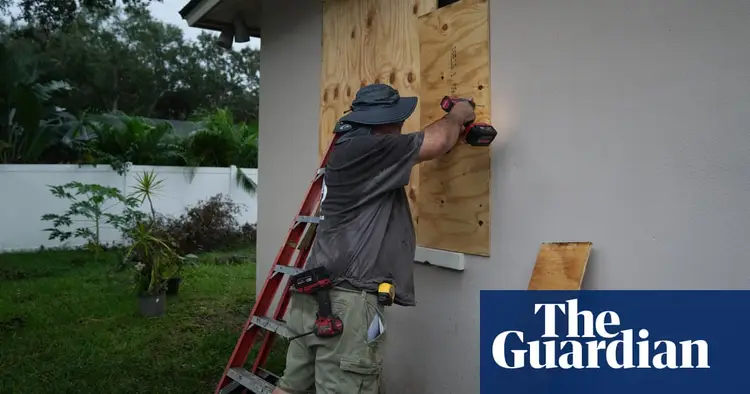Hurricane Milton intensifies to category 4 as Florida braces for ‘major impacts’

Hurricane Milton has rapidly intensified into a category 4 storm, quicker than anticipated, and is set to hit Florida in just two days.
At the same time, the state is preparing for what might be its largest evacuation in seven years, as the storm approaches major cities like Tampa and Orlando. This comes just two weeks after Hurricane Helene resulted in over 200 fatalities and severe destruction that stretched from Florida all the way into the Appalachian Mountains.
On Monday, the storm strengthened into a major hurricane while passing through the Gulf of Mexico, featuring maximum sustained winds of 150 mph (240 km/h), according to the National Hurricane Center.
Even if the hurricane loses some intensity before it hits the land, meteorologists have cautioned that the height of the storm surge—water from the Gulf pushed toward the shore by the storm—will match the highest category it achieves.
Milton is expected to reach the Tampa Bay region on Wednesday and could maintain its status as a hurricane while traveling through central Florida and into the Atlantic Ocean. If it follows this path, it would be the tenth significant hurricane, classified as category 3 or above, to strike the US Gulf coast since 2017.
Experts point to the climate crisis as a key reason for the increased frequency of intense and damaging storms, which is partly driven by the combustion of fossil fuels.
On Monday morning, weather authorities announced that Milton is likely to bring significant rain, potential flooding, dangerous storm surges, and high winds. They also indicated that it may sustain its strength for a few days after peaking at category 4.
On Sunday, Florida Governor Ron DeSantis stated that although it was uncertain where exactly Milton would make landfall, it was evident that the state would face significant impacts.
"I can't imagine any situation in which we won't face significant consequences at this stage," he stated.
"You have plenty of time to get ready – today, all day Monday, and likely most of Tuesday to ensure your hurricane preparedness plan is established," DeSantis stated. "If you live on Florida's west coast or any barrier islands, just plan on evacuating."
With Milton reaching hurricane-level intensity, it's notable that this is the first instance of three hurricanes occurring at the same time in the Atlantic after September, as stated by Phil Klotzbach, a hurricane expert from Colorado State University. Historically, there have been four hurricanes happening simultaneously during August and September.
The St. Petersburg-Tampa Bay region is continuing to recover from significant devastation caused by Helene and its strong storm surge. In Pinellas County, home to St. Petersburg, at least 12 lives were lost due to the impacts of Helene.
By the end of September, Helene inundated regions of Florida’s west coast, causing the most devastation along a slim, 20-mile (32 km) chain of barrier islands extending from St. Petersburg to Clearwater.
According to the National Weather Service on Monday, Pinellas County and neighboring areas like Hillsborough, Manatee, and Sarasota may experience a storm surge reaching heights of 8 to 12 feet above the ground this week.
On Sunday, DeSantis broadened his emergency declaration to cover 51 counties and advised residents of Florida to get ready for additional power outages and interruptions. He stressed the importance of having a week's supply of food and water on hand and being prepared to evacuate if necessary.
Florida officials announced that they were getting ready for the biggest evacuation the state has experienced since Hurricane Irma struck in 2017.
They requested that residents of homes built after Florida updated its building codes in 2004—and who don't rely on continuous electricity or live in evacuation areas—stay off the roads.
Certain regions in Florida, such as the coastal town of Anna Maria in Manatee County, located south of Tampa, have already declared mandatory evacuation orders. Additional areas are expected to follow suit and announce similar orders on Monday.
On the east coast of Florida, authorities have alerted residents to expect significant flooding, power outages, strong winds similar to those of a hurricane, and rainfall amounts between 6 to 8 inches.
In areas of Florida that are predicted to be affected by Milton, several schools and universities have decided to close this week, specifically on Wednesday and Thursday, in preparation for the storm's arrival.
As of Monday morning, parts of the Gulf of Mexico and the western coast of Florida were under various alerts, including hurricane watches, flood watches, and storm surge watches. The National Weather Service also announced a flood watch for all counties in central Florida and cautioned about a significant risk of dangerous rip currents at Atlantic beaches in central Florida.
The National Weather Service stated on Monday, "Milton will be a monumental storm for Florida's west coast."
Tampa officials have made all city garages available for free to residents looking to safeguard their vehicles, including electric cars, from rising floodwaters.
Governor DeSantis stated that around 4,000 National Guard members are assisting state teams in clearing away debris. He also noted that he has instructed Florida crews, who were sent to North Carolina following Hurricane Helene, to come back in order to get ready for the situation in Milton.
Reporting from the Associated Press was included.















































